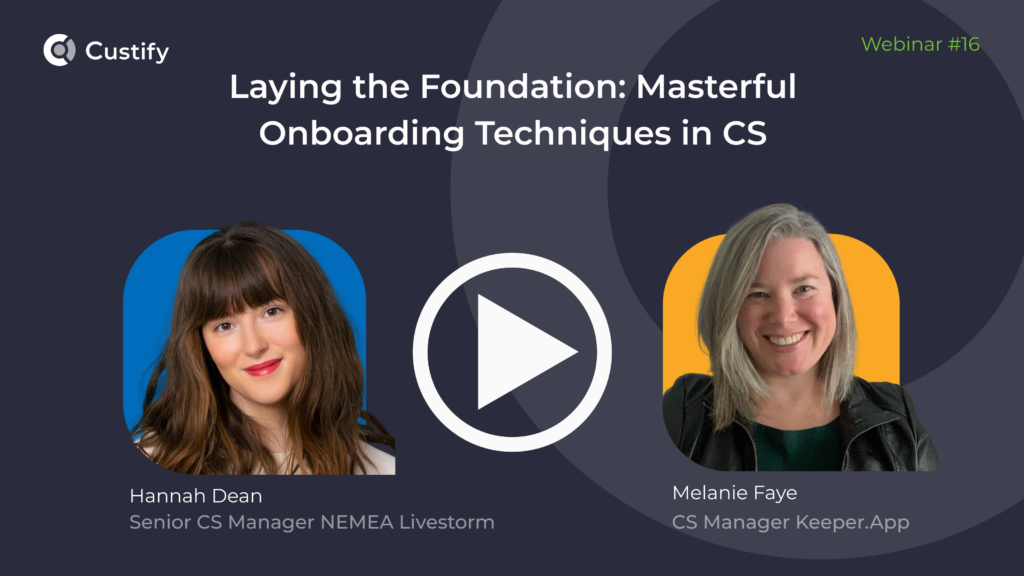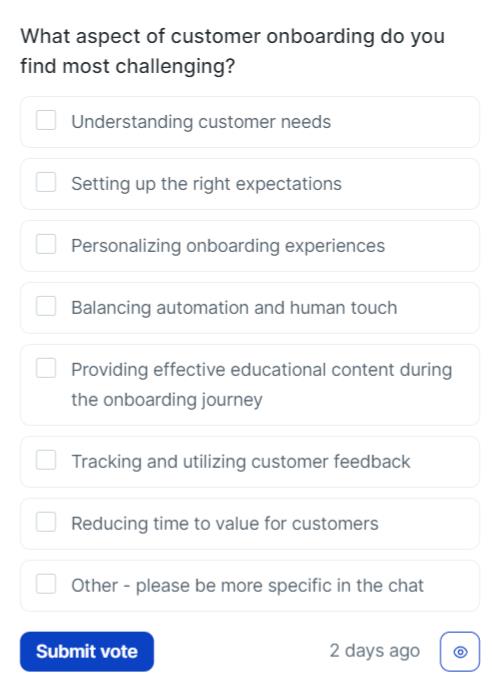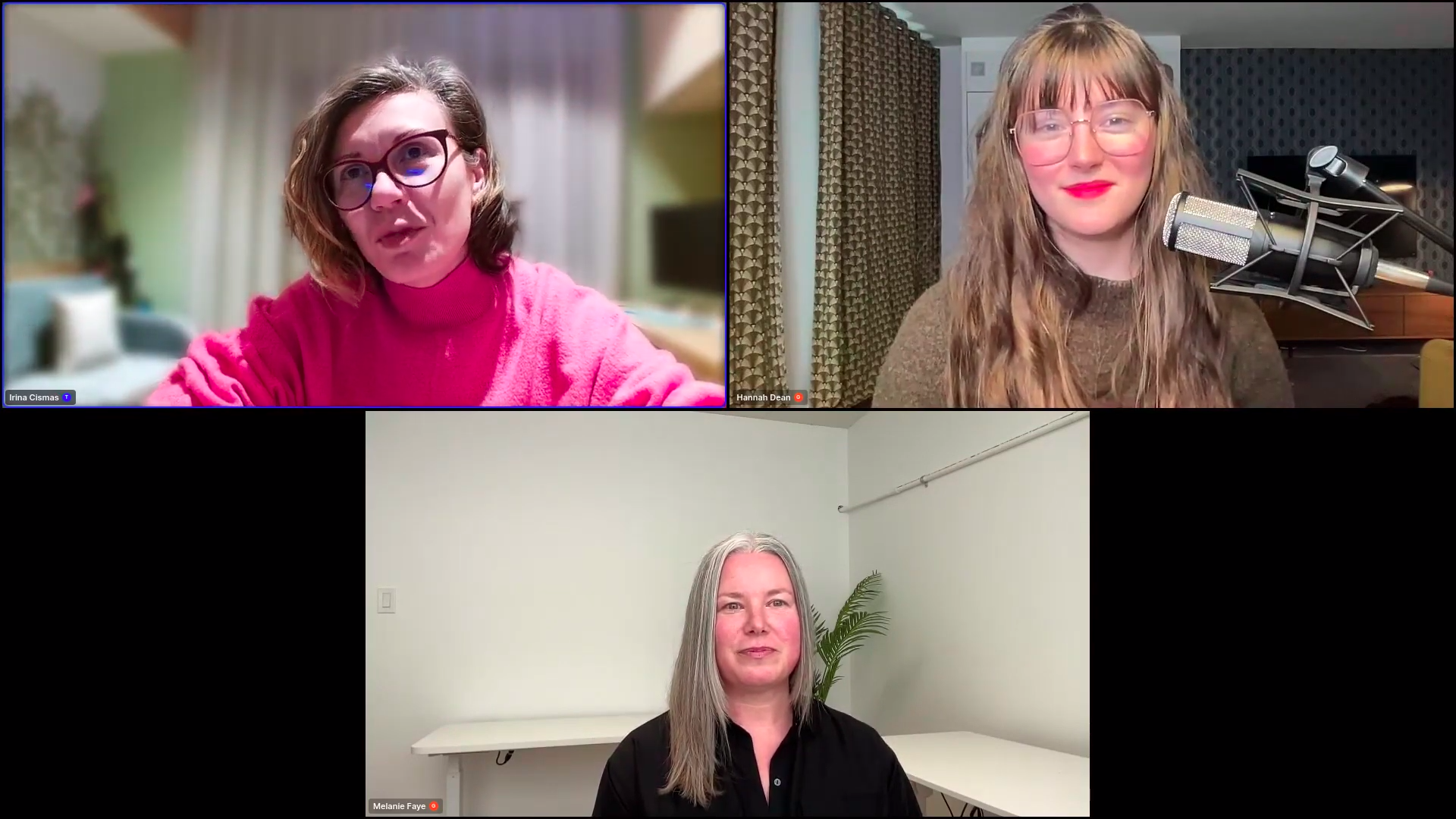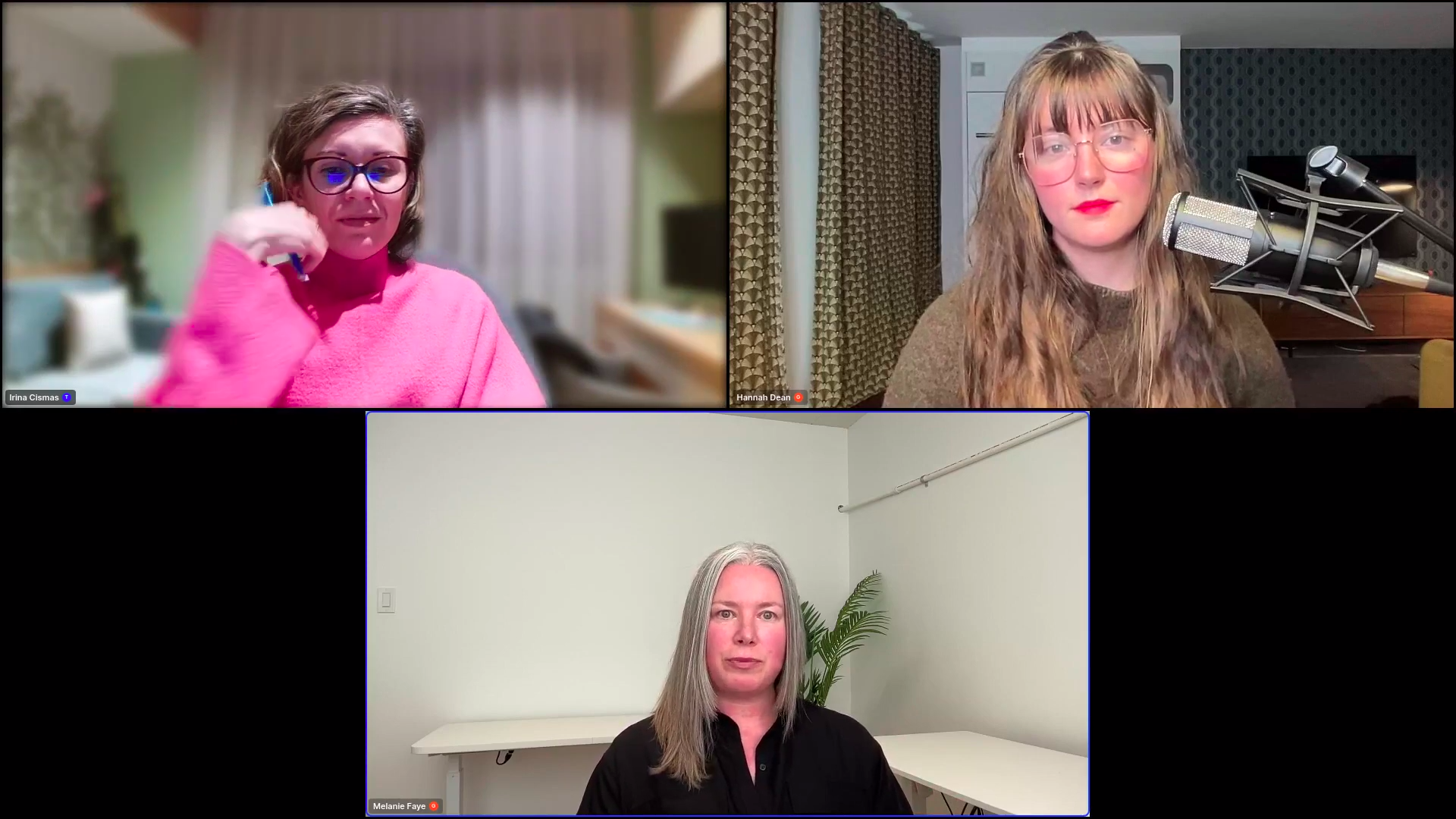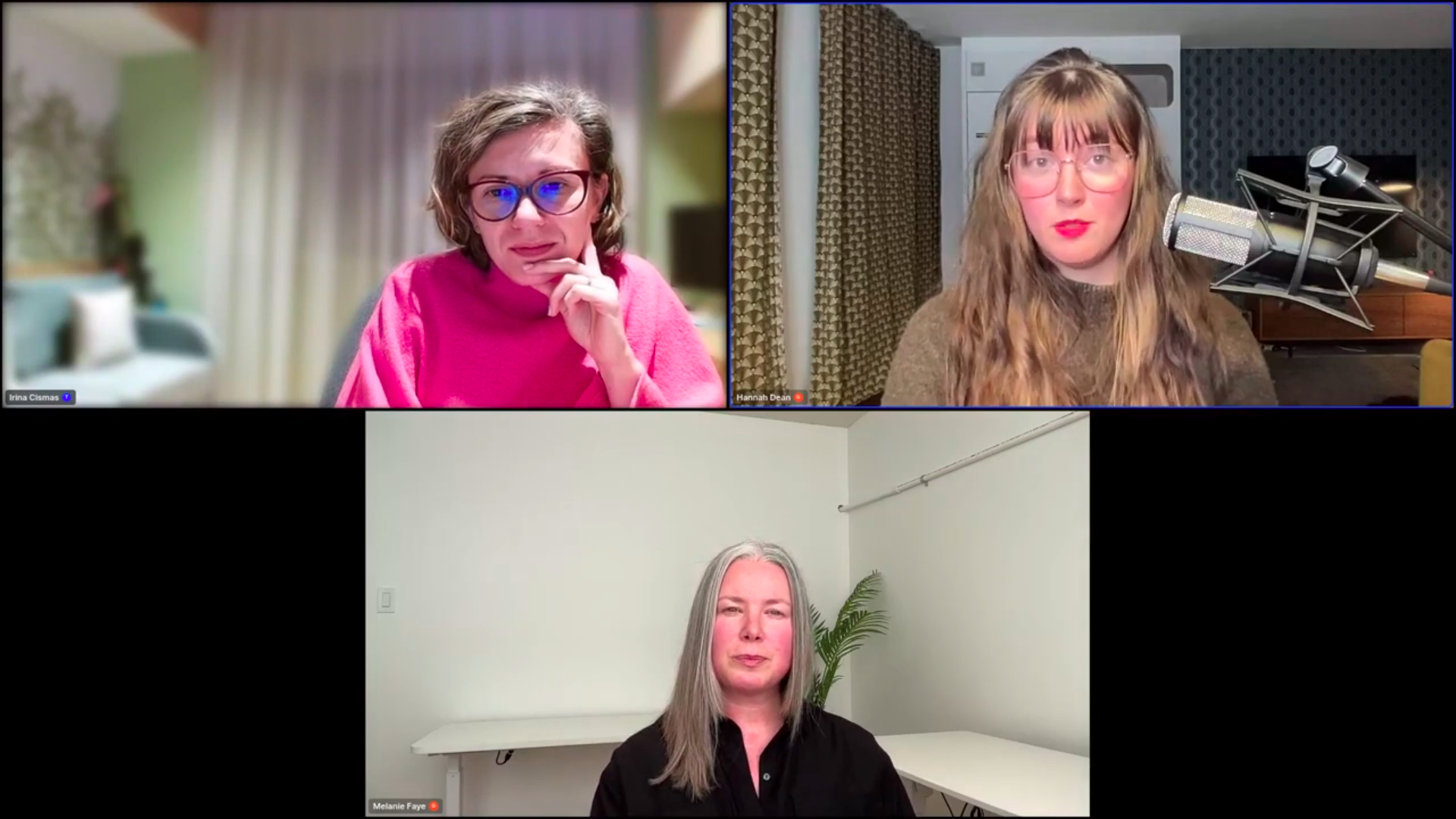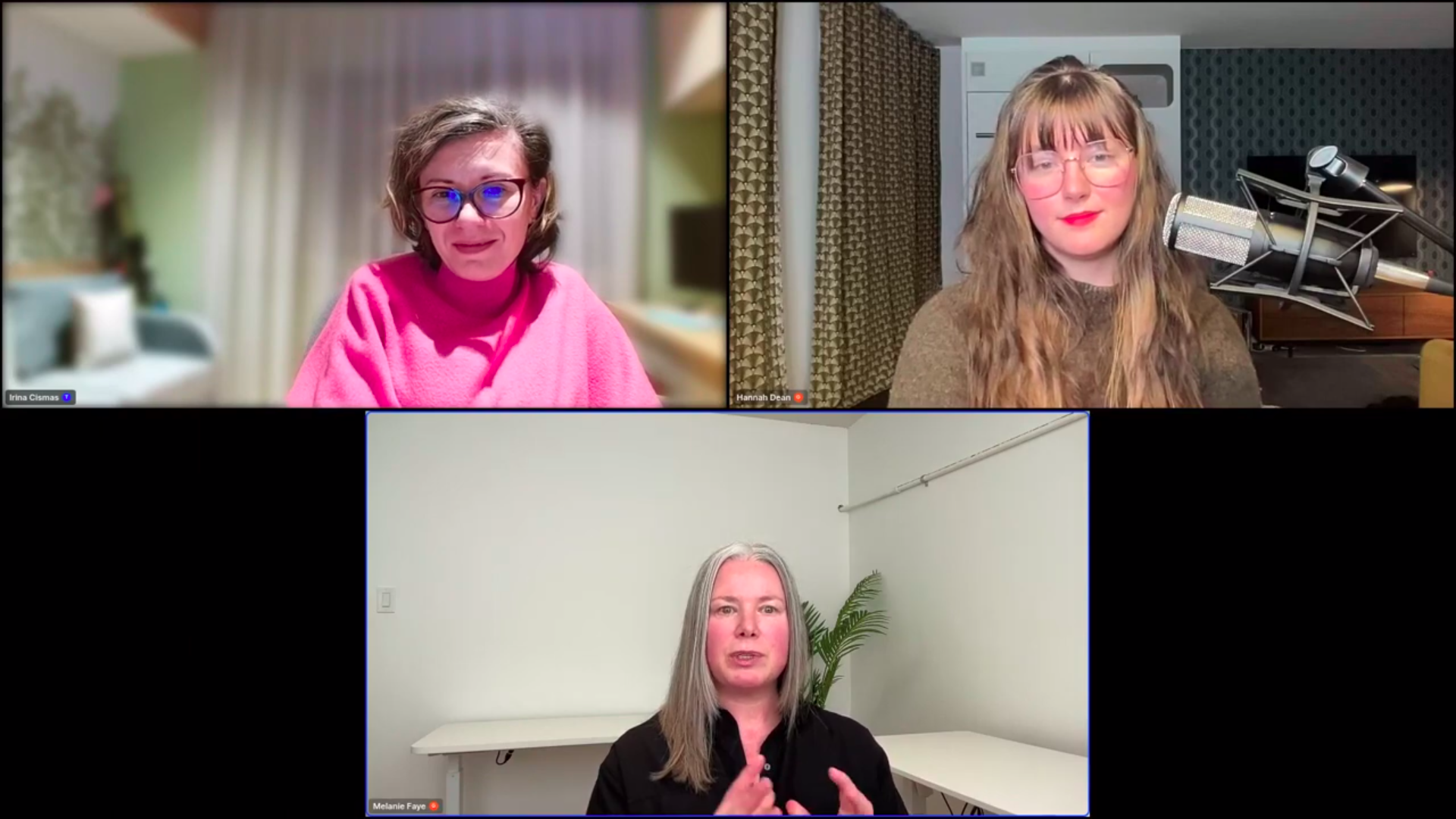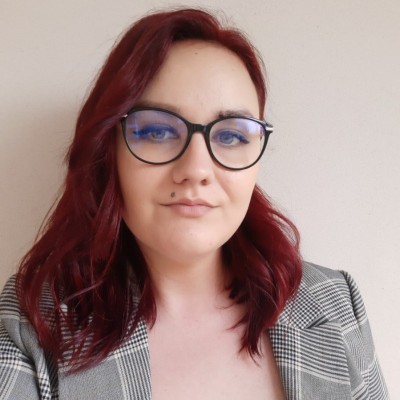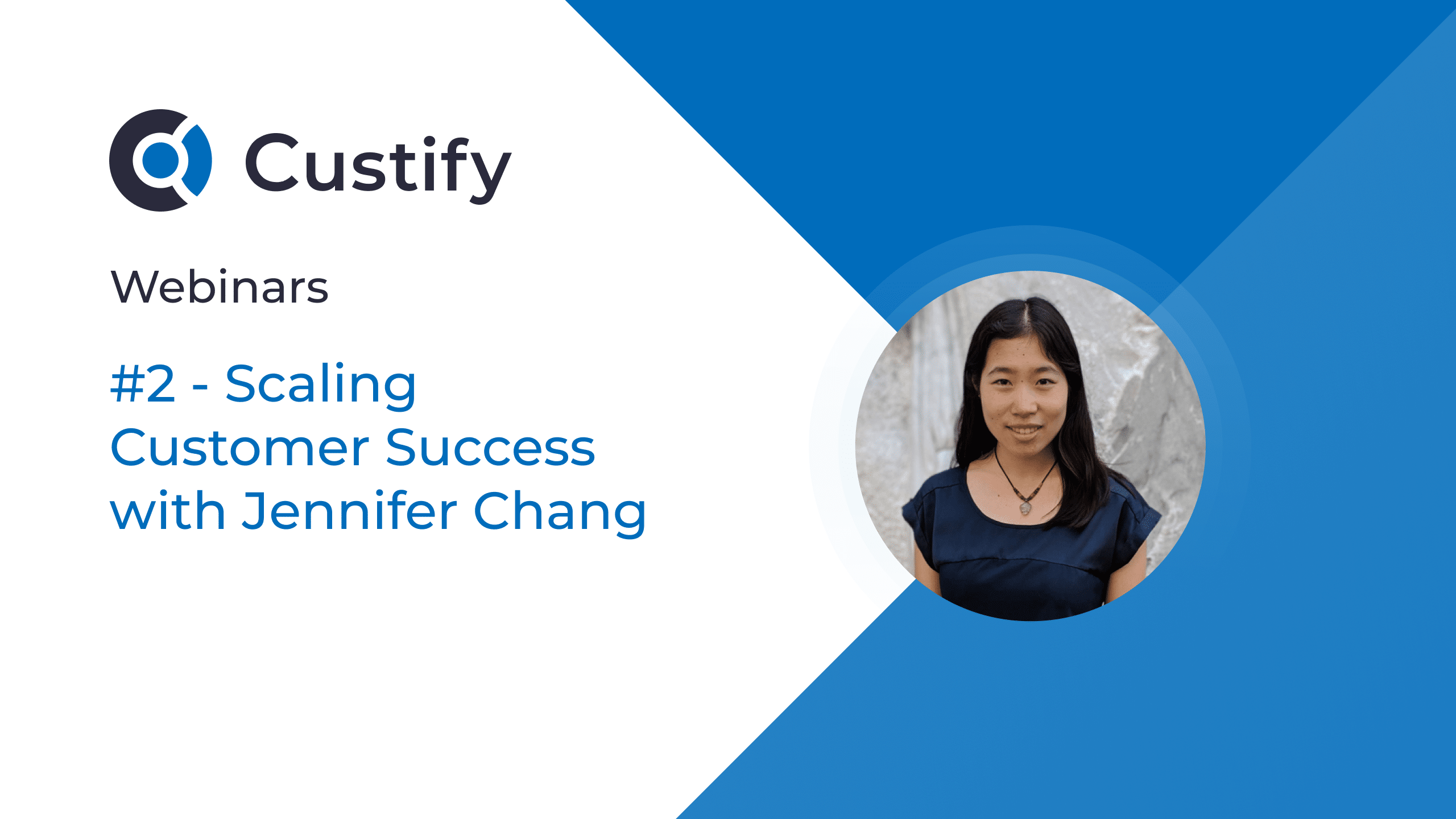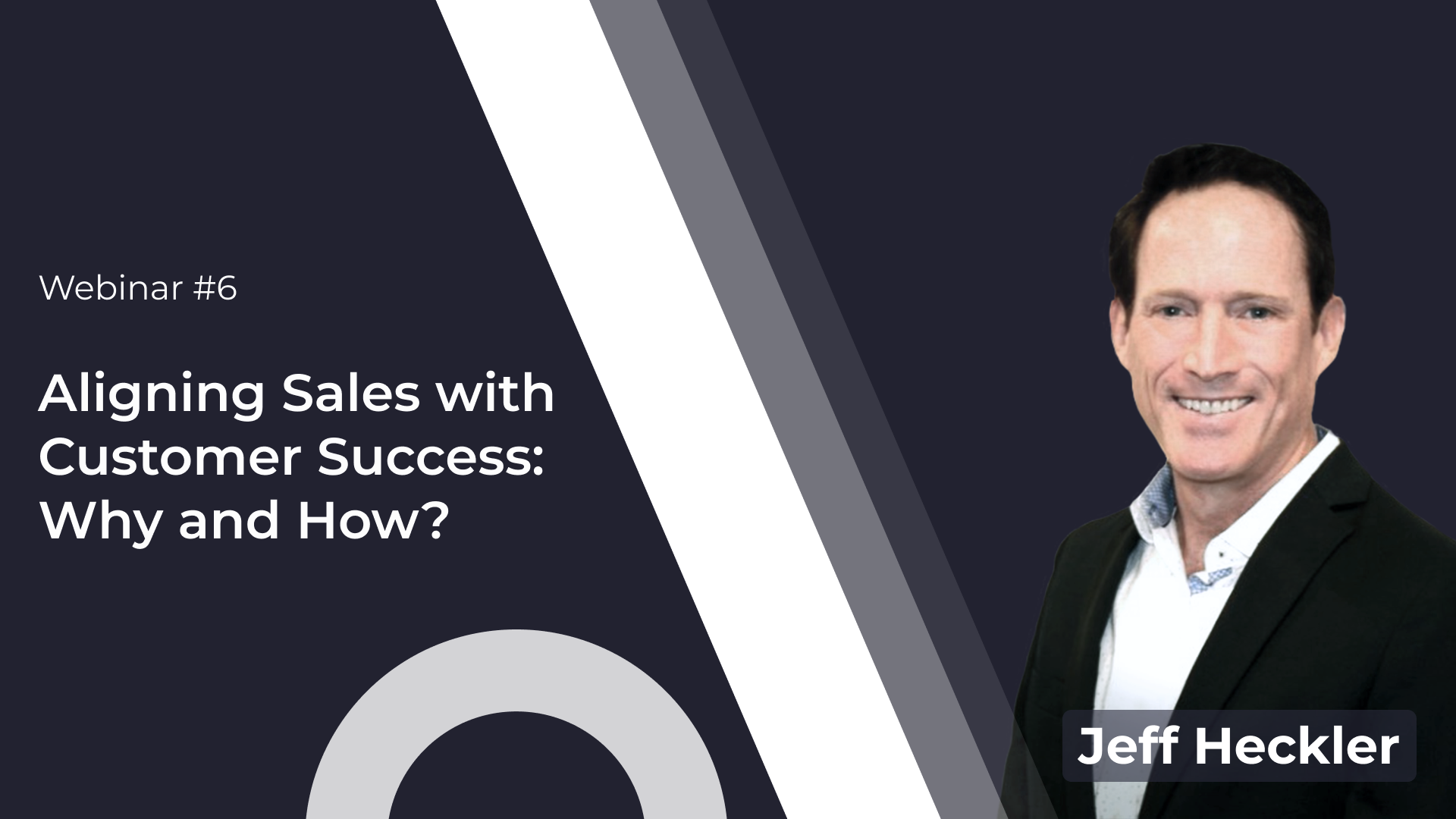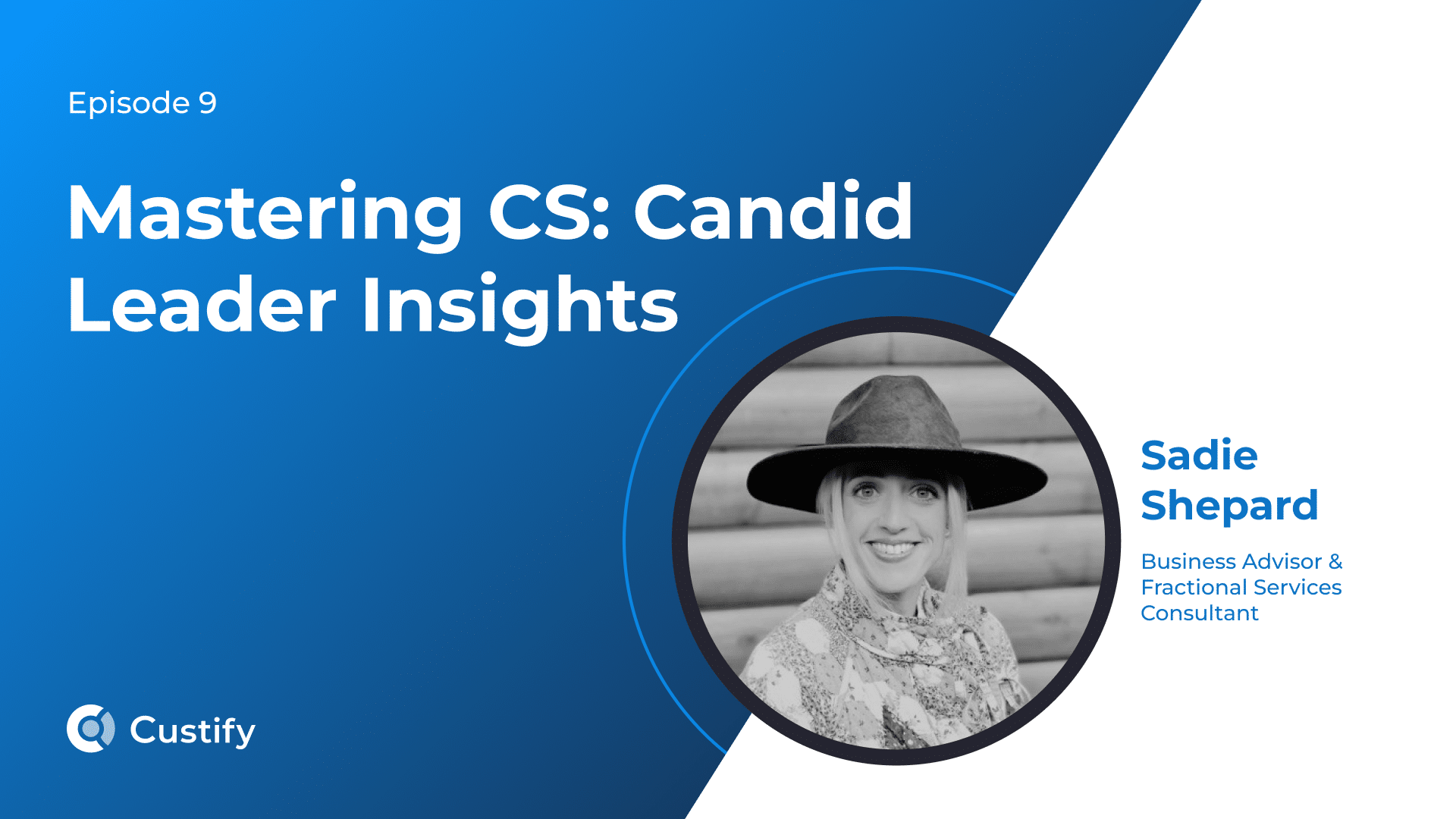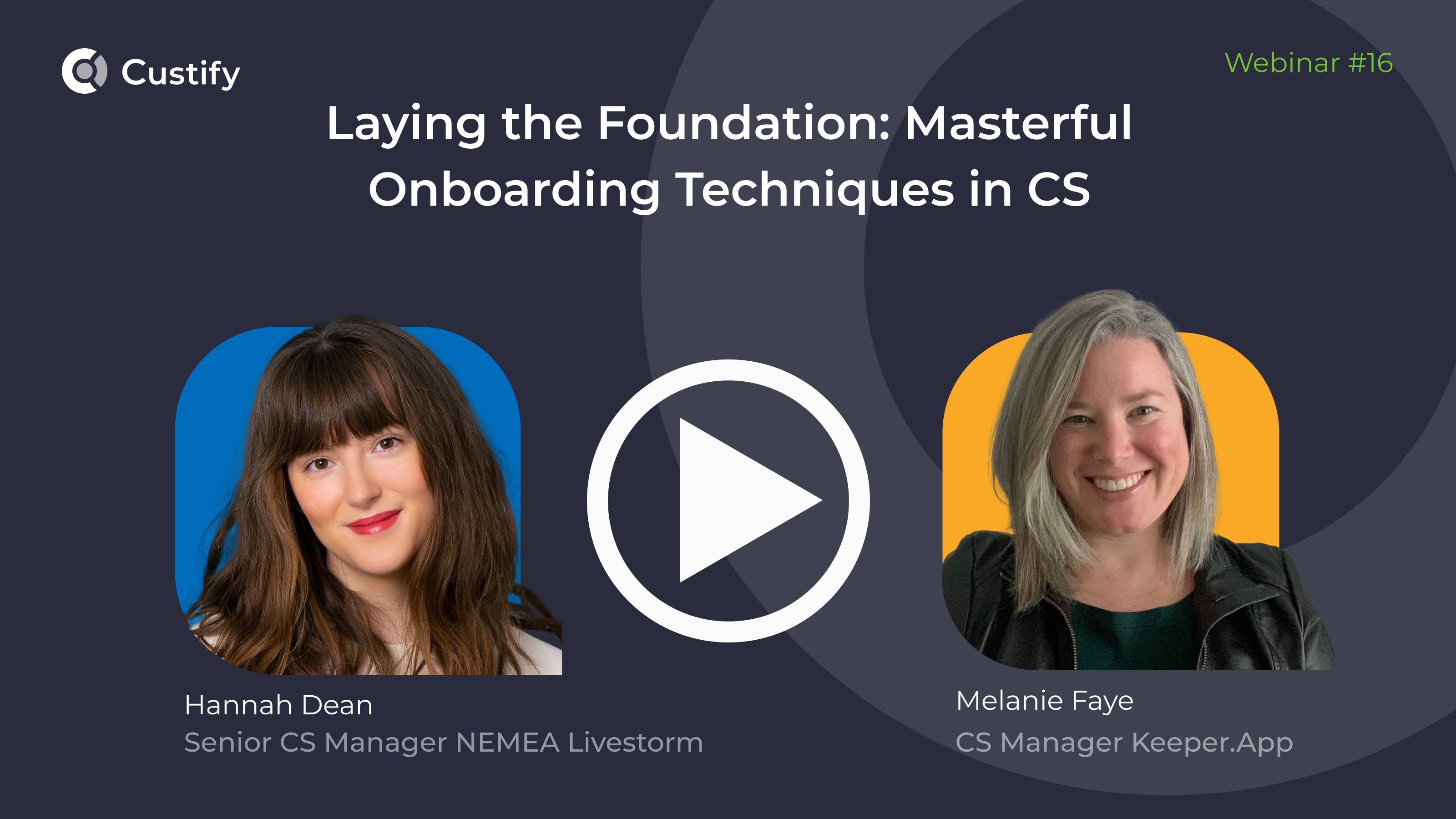Custify’s first webinar episode of 2024 brought together two Customer Success experts, Hannah Dean, Senior CS Manager NEMEA at Livestorm, and Melanie Faye, CS manager at Keeper.App. Irina Cismas, Custify’s Head of Marketing sat down with them and uncovered insights on various topics, including:
- The challenges in the onboarding process
- How to lower time to first value
- How to set up clear expectations
- How to handle conversations with customers
- The importance of onboarding when it comes to renewals
Intro
Irina 00:01
Hey, everyone. Welcome and thanks for joining us today. I’m Irina Cismas, Head of Marketing at Custify and I’m going to be your host for this webinar. Can you believe it’s already the end of January? For me, January is all about new starts. So I decided to kick off the 2024 webinar series with a topic that’s all about beginning things the right way.
So today, we are talking about onboarding techniques in customer success. And I’m lucky to share the virtual stage with two amazing guests. I have Melanie Faye from Keeper.App, and Hannah Dean from Livestorm.
Melanie, and Hannah, thank you both for joining me today! Before we dive into our discussion, I want to run all of you through a few housekeeping items. This event is being recorded. So rest assured that everyone who registered is gonna receive a copy of the event in their email, feel free to address all the questions that you have. But the three of us are here to try to unbox as many challenges as possible in customer onboarding, use the question tab, which is the bottom right of your device word chat, and I’ll try to monitor while we are having this conversation. We’ll address them in the context of the discussion where at the end, we have a dedicated Q&A session.
Speaking about the whole onboarding topic, at least we are taking pride that, at Custify, we try to have it in our DNA. And we understand that every business has its own journey. So we want to offer the guidance we want to offer and support you as best as we can. So after this webinar, if you are interested, our team will be available to discuss specific use cases, specific needs and share best practices, and make sure that you are set up for success. Now, I wanna kick things off, like always with a quick poll, and I know that we have a pretty solid audience that is watching us live.
So I’m curious to know what aspect of customer onboarding you find most challenging? I’m gonna go and publish now a poll, give me give me one. Please vote. We’ll give it a few.
Irina 03:08
Is everyone seeing it? Because the part that I don’t see is the distribution. And we’re gonna start the discussion, by commenting together with Melanie and Hannah, on the distribution.
It seems like reducing time to value for customers, and balancing automation and human touch, we will have a dedicated topic about and I’m gonna ask both Hannah and Melanie, how do they keep the balance between automation and human touch.
Reducing time to value for customers seems like the most challenging part, but we’re gonna give it a few more minutes. And then we’re gonna start the discussion. In the meantime, we also have to get customers to follow the implementation plan that we know will make the most successful. That was that was other. Thank you, Heather, for sharing this.
I remember that at some point. But I think I don’t know 10 years ago, speaking about implementation plans. We had the discussions and we were trying to define first-time user experience flows into the product. When we were reviewing the way product the way the users were interacting with the product, they were totally in a different way than what we imagined and I remember a business analyst asking me “Why aren’t the users using the product like this?” We designed it. And so it was like, because they are undisciplined users, they don’t want to follow us, our plans, our workflows, our product tours, onboarding journey, and so on and so forth. But that was yeah, that was, that was funny.
So I think it’s fair to say that one of the most challenging things that our audience finds is reducing time to value. So Melanie, I want to start the discussion with you. I’m curious, how do you tweak your initial customer interaction to tackle this challenge, reducing time to value? How do you adjust the onboarding process? Having in mind that this challenge, and then Hannah will continue? I’m curious, how does Livestorm do it?
Reducing time to value
Melania 06:02
Yeah, I think that, for sure. This is what I would also consider the biggest challenge. For me, it’s really important to define, as a team or as an organization, what time to value is. Without that definition, or that understanding of how your client will reach that first value and knowing what it is, it’s really hard to approach onboarding. Being able to get to that point is crucial. So first of all, defining it is key.
Second of all, knowing that with a lot of our platforms, there are many features you can cover in an onboarding. Value for one customer might be totally different than for another, especially if there are different paths to having that customer achieve their desired outcomes in the software. So, defining it first and then approaching the onboarding with that knowledge is vital. They might not be interested in certain features, and there might be one feature that really stands out to them. That’s where that customer is going to find value.
Then, focusing on that in the onboarding and helping them reach that desired outcome first is essential. After that, start considering other aspects of expansion or maybe introducing other features. This is based on things that they hadn’t thought about how they could use the software differently, or incorporate other processes based on the software features into what they’re doing in their day-to-day activities.
Irina 07:31
And over to you, Hannah. How do you address the time to value challenge from the first customer contact?
Hannah 07:44
Honestly, Melanie hit it right on the money. It’s really important to define and then approach because this allows you to focus on their needs and objectives to achieve long-term goals. Another crucial aspect for CSMs to consider is the type of service level offered to clients. Depending on your organization, this may vary, but in my own organization, we consider service level or perhaps ARR. This determines the level of support the CSM will provide.
So, are you dealing with a client needing a full onboarding experience, with continuous training and a focus on realigning specific feature capabilities or objectives? Is this an individual seeking less autonomy and more support? Or is this someone with limited access to the CSM? Realistically understanding their perspective and needs is vital. It helps you better define and approach their objectives, assisting them in achieving desired outcomes.
When we encounter any misalignment in the future, we consider it might be due to a feature maybe being mis-sold, or the client having misconceptions about the product. But misalignment can also stem from the level of support and how they’ll have the support in place to approach and successfully achieve a certain outcome. Ultimately, this depends on the level of service and support your organization can provide, or what you, as the CSM, can offer.
So, take the time to ask every single question during onboarding and kickoff meetings. Ensure there’s strong alignment and clear use of information and insights about their needs. This will help you guide them towards their goals effectively.
Onboarding customers step by step
Irina 09:40
We’re gonna tackle the alignment part later on. So I’m going to ask both of you to basically describe what the onboarding process looks like in Livestorm, and then we’ll go to Keeper.App to be super specific. And then we’ll go into the follow-up with questions of why you did it like this. So, Hannah, how does the onboarding process look like when it comes to Livestorm?
Hannah 10:19
Yeah, absolutely. And in full transparency, the onboarding really starts before that kickoff event, you know. It’s before the call is even scheduled. It’s the communications that we have internally, from our AES. We meet together, and we really have a very strong handoff so that we have a clearer understanding of who we’re going to be working with and supporting.
I’m really fortunate that my team is just so people-centric in the most sincere form. So we’re creating a milestone checklist to better allow us to prepare and have a 360 view of our clients before they go live. In our case, I work with a lot of different individuals.
Irina 10:59
You mentioned checklists. What’s included in those checklists? What’s important for you guys?
Hannah 11:07
Yeah, absolutely. Ultimately, it’s really going to depend on the context that you have in an organization. I work with a lot of marketers, so after working so much with them, and honestly, they’re just the most thorough, thoughtful, and very brand-centric teams, that’s just fantastic. I’ve really built out some guidelines that help me lead and facilitate conversations as meaningfully as possible. So, what does that mean? It’s asking questions about what type of brand perception they have as an organization, what type of engagement they have externally, if they have any past experiences, and what their digital footprint looks like. I’m really trying to get a very wide view and understand who they are.
So that ultimately, when they’re ready to host any sort of internal or external event, I can take that first step call together and say, “Okay, I have an understanding of who you are. I want you to tell me what we are working towards. Are you already aware that this is the existing brand image that your team has? Is this the baseline, or are we working on something entirely different?” So, I’ve really used a lot of these different concepts that I’ve started to almost steal away from these marketers that I’ve worked with who’ve been so insightful, really to understand honestly, who a company is. Because understanding who a team is before that call is going to give me better context on the right questions to ask.
Did my AE share any insights on any KPIs? Do I know anything about past experiences? The worst thing I think that we, as customer success managers, can do is go in thinking that we can’t ask questions, which I think is absolutely crazy because we’re here to support our clients. We really want to think about what we can do to elevate that experience, and what we can do to make sure that they are fully adopting and even expanding their use cases into different feature capabilities and concepts. So it’s asking those questions, it’s really giving a full in-depth 360 view of who they are, and how we can take that further with more context.
Irina 13:10
So you mentioned that the onboarding journey starts prior to the initial meetings that you have with the customer. What happens after the initial meeting? What are your steps? How long does it take for your onboarding process?
Hannah 13:33
Great question. So, for the onboarding that we have, typically, we’re leading up to that first event. And what I love is that we give this about a 30-day period. We have the kickoff call, and then, during that 30-day period following, we really want to give ample time to schedule a training session together. After we’ve gone through training, we have a Q&A, making sure you have some questions after getting a bit more hands-on experience. Maybe we’ll go through a rehearsal together, have some live event shadowing. But ultimately, we want our clients to really feel very autonomous, so that long term, the customer success manager can focus more on scaling strategy and operations, and less necessarily on how they can use the event room, so to speak. That’s one thing that I’m really considerate of, and something that is encompassed in that onboarding journey.
But one thing that I think is really unique about my team is that when you are an enterprise customer here at Livestorm, you actually have a dedicated CSM. So you are continuously there throughout your whole lifecycle with one CSM, who’s been with us since day one. They’re there, helping nurture these new concepts, exploring new ideas, and really scaling those experiences. I know in other teams and contexts I’ve worked with, maybe they focus on adoption or just onboarding, and they pass a contact off to the next team member. But I’m actually really fortunate because it’s such a fulfilling experience to be able to be with a client from that kickoff and really see their growth and development together, and see them get excited about something that I’m so excited for them about.
Irina 15:06
Javier mentioned that one of his challenges is getting the customer to book an onboarding meeting. And you mentioned this. Do you have this situation in which people, even if they have the option of talking with the CSM, they do refuse to?
Hannah 15:31
Yeah, absolutely. I know, sometimes it can feel like you’re chasing down clients, trying to get them to stay on a call, or, in the worst case, they book something and just don’t show up. We wanted to be really thoughtful about this. Something that’s really helped is that a kickoff call can just be reviewing the contract, just giving an overview. Maybe they already feel like they’ve got that done, they already know what’s included, and they don’t need that call.
So what I like to do is create the kickoff document, and then I’ll actually link that and add in a scheduling link directly as well. That way, they have the documents, and they can do a quick overview themselves. From there, if they have questions, we can either have a 15-minute call or dive directly into a scoping and strategy call or training. Realistically, the role of the customer success manager is here to support their needs and their objectives. So, if the kickoff call doesn’t fit into their needs, and they have something else that comes at a higher priority, I want to take that into account. There’s no one-size-fits-all.
Irina 16:29
Awesome! Melanie, let’s switch gears, how does the onboarding process look like in the case of Keeper.App?
Melanie 16:37
Yeah, we do things, I think, maybe slightly differently than other SaaS companies that I’ve seen before. So, anybody who comes to the website, or is a lead, goes through the demo process with an AE. Typically, they’re filling out a form. If they indicate on this form that they have nine or more clients, we cater specifically to bookkeepers and accountants. If they have nine clients that they work with on a monthly basis, they go right into this sales phase where they’re having a demo with the AE. On that call, that’s actually when they’re booking an onboarding call with the CSM. So, they have not subscribed yet, they haven’t signed a contract, they’re just a prospect at that point, and have an onboarding.
Because our platform is so big, and there are so many features, it’s really difficult for someone, especially someone who hasn’t used technology before and wants to streamline their processes, to come in and know what to do when they get access to the platform. So, we start off with a 60-minute onboarding sync call. Then, after that, they have a few days to explore the platform, and we come back together in a 30-minute sync for Q&A, and to finish up any onboarding items. That typically is the end of their free trial. They have a 14-day free-trial process, and at the end of that, we would be looking at whether they are converting or not. We’re working with all clients. Some of them will subscribe during that free trial process if they’re really excited about it. Others just need a little bit more.
At the end of it, we have the autonomy to extend a trial if we need to, or have more meetings if they need a little bit more during that free trial period. So, we can be really flexible based on their needs and what type of customer they are. Some will jump in and they’re really tech-savvy, and they get really excited and get fully set up before the trial ends. Others need a little bit more hand-holding, or they’re not sold on the technology. They’re told by somebody else on the team they’re going to be using it, they’re not completely sold. It’s just another app or another platform. So, those are customers that I like to take a little bit more time with. I have some automated emails that I send out too. But for the most part, for me, what works really well in onboarding is increasing the touchpoints with customers, whether that’s with extra calls or a few extra emails that are going out with tips and tricks, or things that they might not have thought of that they would want to take a look at while they’re on the free trial.
Irina 19:19
Let’s try to see if we can answer Amanda’s questions: How long, on average, would you say your onboarding or implementation takes from start to finish with a customer? I think you Hannah mentioned something like around one month if I recall correctly, would that be okay? And understanding that every customer is different. Is there an industry standard we should strive for when it comes to when it comes to time to value I would say.
Melanie 19:59
I think that, for me personally, I like to give the client time. I can usually assess on a call whether they’re going to jump in and take full advantage of that free trial, or even subscribe and use that time afterwards for implementation, how quickly it’s going to go, and how easily it’s going to be for them to reach time to produce value. There are other clients that I know right off the bat it’s going to take longer; they’re going to need a little bit more work. So we don’t particularly have an industry standard, so to speak. But we have an idea that we would like time to value to be within the first 30, or at least 60 days. They have to be adopting, engaging, and using the product to find value, ideally in the first 30 days. And that’s kind of the standard that we’ve set.
But it can take longer, just depending on their needs, what’s happening in their business. Sometimes they’ll subscribe and be really excited to get going but don’t necessarily have the resources they can allocate to the full implementation. So, I try to be a bit flexible and work with them based on the timeline we set on those first couple of calls. One of the questions that I’m always asking is what their expectation is of how implementation looks for them, and then how we can get them there.
Lack of resources for implementation
Irina 21:24
I have a curiosity, because I know that I’ve heard this scenario. So we’re people trying to adopt a product, but they don’t have resources for implementation, how do you mitigate this risk in the onboarding?
Because from my perspective, the onboarding process is compromised, if you don’t have the resources necessary to implement the solution that you just bought. How do you work around this part?
I’ll continue with you, Melanie, and then I’ll switch to Hannah. I’m not sure if you have this situation with implementation resources, because usually, Livestorm doesn’t require development resources to implement. So I’ll start with Melania, then I’ll move to move to Hannah.
Melanie 22:15
Yeah, I think that’s where having a plan or a timeline upfront is really important. So, me asking questions about what implementation looks like for them, how soon they would like to be implemented, and what features they are going to be using, makes a big difference. You know, how much of the platform are they going to be using? And then from there, we come up with a timeline. Are they, you know, have they set aside time to actually get in there and implement the product, add new users, get those users trained? All of that’s going to be really important to their success over those 30 or 60 days. So those are things that I like to build into the timeline.
And then we can revisit them because, you know, if I’m noticing that they’re not logging in, or they haven’t added new users, or they haven’t built out any reports yet, or that type of thing, that’s kind of my first indicator that there’s something wrong, and maybe the timeline is no longer working. So, I think keeping in constant contact and communication with them, so that I know whether there are any changes that we need to build back into that implementation timeline, is crucial. That way, we can still meet their goals, but it just might be stretched out a little bit longer, or we’re doing things in a different way, where we’re tackling a couple of features instead of the entire platform. So, I think just being flexible and able to accommodate their needs is going to be really important.
Irina 23:38
How that is different from Livestorm, do you face the implementation part?
Hannah 23:44
Yeah, absolutely. One thing that’s really helpful is that at the enterprise level, you do have service hours, and these can be used in different ways. As the customer success manager, we really do reiterate that we are here to act as your team’s partner. We don’t want to just be another tool in your stack that’s being underutilized. I do have clients who exactly have similar issues where they just have a lack of support internally to achieve a concept, or maybe they have a lack of bandwidth internally. So, this is my role as the CSM to really understand what gaps are currently here that can ultimately decrease usage, support a lack of adoption, or result in a long-term trend.
On my end, I’m really reviewing and understanding. Okay, so here at Livestorm, my champion is having some issues; they don’t have enough support to actually host events. There have been many occasions where I’ve actually gone and co-hosted or supported events myself. So, am I moderating chat? Am I acting as support or a moderator? Or am I working with my engineering team to help create a custom landing page or custom website? I’m really fortunate that, at the enterprise level, we have clients who are here for at least one year, up to multiple years, so we do have that time. We do have the flexibility to be able to use those hours and really help refine that partnership based on realistically what they need.
Setting up clear expectations
Irina 25:06
When you mentioned service hours, it brought me to the idea of setting up to your expectations. And I want to talk about it. Because you have a number of service hours, you promise a thing, then the client might understand something else. I want to ask both of you, how do you make sure that you set up clear expectations for your customers in the onboarding process.
How do you define those rules of engagement that are very important when you are starting a new relationship and I consider the CSM client as being in a relationship? Sometimes we enter in a relationship, and we need to have some basic rules. How do you make sure? Melanie, let’s start with you.
Melanie 26:06
That starts for me with the initial email, like the onboarding is booked. I get included in an email from the AE, just saying, you know, next steps, the onboarding is going to happen with Melanie and you’ll be meeting her on such and such a day. Then I chime in, letting them know that I’m excited to meet them. I just like to take that extra step and set the tone for how the actual onboarding call is going to go. I want them to be excited and understand what the timeline is. So, I have a timeline PDF that I share, which explains your onboarding call, your sync call, and then after subscribing, here’s what it looks like to work with me, so that there is no miscommunication. They have a full understanding of what the commitment on their end is going to be when they’re onboarding, and then what my level of commitment to them is.
So, I just want them to understand I’m here for them. This is the timeline. And then, when I’m on the call with them, I also let them know that it is flexible. You’re not set or stuck with these two calls, and then we come back together on a monthly basis. Ideally, it can be whatever their needs are; that’s what I’m there for. So, I’m not only their strategic partner, but I’m also there for a little bit of extra help, if that’s what they need to fully implement and get up and running and understand the product. Because like Hannah said, we don’t want them to just be paying for this platform that they’re not going to use, or that they’re too scared to use, or too confused to use. We want them in there, benefiting from the software, so that when it comes time to renew, it’s a no-brainer. They have no reason to think about not renewing for that second year.
Irina 27:50
Hannah, over to you. How do you set up clear expectations?
Hannah 27:56
Honestly, I love this question just because I think that I’m going to say an unpopular opinion. And I know it’s going to feel weird as a customer success manager to say this. But what’s really important to remember is that when you are here as the customer success manager, you are here as a mutual partner in a relationship, right? So here at Livestorm, you can have 30 minutes a month, or you can have an hour a month, or three hours a month. It’ll depend on your contract, right? So it’s really important for you to have a very clear understanding on that first kickoff call together to make sure you’re well aligned. You ask the questions and say, “What are your KPIs? What do you expect from me?” But also really be mindful about the contract limitations and expectations.
It’s important for a CSM to know the limit and when to say no, because what we are offering is actually part of your contract. It is part of the service that you’re being provided. So if there’s a misalignment, so to speak, and maybe they don’t have the right service hours, you can go ahead and communicate this to the AE and help push an upsell opportunity. And really help make sure that there is a strong alignment, there’s the correct contract in place. But you’re not going outside of your scope. I know that CSMs love to be people pleasers. We want our customers happy, we want them to be successful and to renew. But also, we do want to be mindful about the scope and the limitations that a client at a certain service level might have. And if they need additional support, or maybe they need a certain functionality, we need to make sure that we’re able to support them and clearly communicate what they need in order to achieve a certain goal. And just really be mindful about what their long-term goal is, right?
You know, it’s one thing in the kickoff to say, “What are your goals? This is how you can work with me.” But relationships change over time, right? And we want to be good partners, we want to make sure that we’re clear communicators, we’re timely. And if anything changes, or their contract will adjust, or maybe they have a new scope or a new project, we want to be mindful of this so that we can equally continue to support them. It’s not a one-time, everything is completely set in stone. Absolutely not the case. As we know, in customer success, things are constantly dynamically changing. And so we just want to be careful and mindful about that.
Customer expectations pre and post-sale
Irina 30:13
Speaking about misalignment, have you ever encountered a situation where customer expectations set up during the sales process didn’t align with what happens post-sale? And how did you mitigate it? How did you handle those, Melanie? I’ll start by answering this question with you.
Melanie 30:36
I think, unfortunately, we’ve all run into similar situations before where there’s a misalignment or even a miscommunication or misunderstanding somewhere along the sales process. I actually just had this happen a couple of weeks ago with a new client. She onboarded understanding in the sales process that there was a feature launching in about two months. She assumed it was live at that moment. When I went back and watched the call, because I have access to the calls on Gong, which is really helpful, I could see that on her end, she really understood this feature was live, but he didn’t quite pick up on that and didn’t communicate otherwise.
So she onboarded, and when I got to the end of her free trial with her, she was asking how she gets access to this feature. I mentioned that it wasn’t live yet. Then we dove into whether this was important to her, if this was a blocker, and what this meant for her decision to subscribe going forward. We do have a workaround in place for clients at the moment when this feature isn’t live, but she wasn’t aware of it. So we put that in place, but we’re also giving her two months free of this feature when it does launch, just because, you know, at the end of the day, it was not the AE’s fault. There was a bit of miscommunication on the call, and he wasn’t fully understanding what she was asking. But she’s brand new, and we want to keep her happy. So in good faith, we’re offering her a couple of months free, so she has a good experience and continues to think positively of Cooper as a new subscriber and client.
But typically, what I like to do in this case, I didn’t get the AE involved. I made him aware that there was an issue and that she wasn’t happy. But depending on the severity and how much of a blocker it is for the client, I do like to get the AE involved and then see how we can progress forward or what it will take to move forward. Then, hopefully, we come to some type of either short-term or long-term solution for them.
Navigating difficult conversations
Irina 32:42
Hannah, how do you navigate those difficult conversations? Or are they difficult for you?
Hannah 32:50
I mean, no one wants to have these conversations. And unfortunately, they do happen. One thing that’s really helped me be as proactive as possible in this case is, as I’ve mentioned, really considering the onboarding prior to that kickoff call. So, I look at the handover message. What is the AE anticipating? What is the communicated usage, feature capabilities? Who am I going to be working with? I do like to schedule a call with the AE before we have that kickoff call together, just to make sure that there’s no misalignment so that ultimately, maybe they do need a feature that doesn’t exist, or maybe it’s not released yet. I can be aware of it in advance and so that I can proactively come up with a solution or workaround.
It’s really important for me to be a strong communicator and be as transparent as possible. When my clients come in, they’re going to be here for at least one year together. And I want to make sure that I’m as mindful and intentional about how we’re able to work as partners together. If they feel like they’ve been misled, or if I say, “Oh, sorry, it’s not going to happen. That’s it. End of story, book closed,” that’s not going to help improve the situation or my client’s experience. And ultimately, I want to make sure that we do find a solution.
So, communicating as proactively as possible with my AEs, and then from there, discussing with management as needed, or with my developers or solutions team. Ultimately, it’s on a case-by-case basis, but proactivity is the most important thing that we can do here. Then we can try to alleviate the situation before it starts to burn.
The importance of the onboarding phase
Irina 34:24
How important is this onboarding phase? I was told that usually the renewal is decided in the onboarding phase. What’s your take on this? Do you agree or disagree? Is the renewal decided in the onboarding phase? Hannah, I’ll start with you, and then I’ll switch to Melanie.
Hannah 34:51
I’m really curious, and I would like for someone to convince me otherwise, but I would definitely say no. Here’s the thing: if you are so confident that someone is going to renew at the end of their contract, then how long did they sign for their contract? Is it a month, is it a year, is it five years? A lot can change, you know, strategy changes, implementation changes. You can have as complex systems as you’d like, or as simple systems as you’d like.
The thing is, I will never walk into a conversation where I will automatically expect them to renew because we’ve just talked about sales misalignment. If, in that kickoff call, you say they are for sure going to renew in one year, no problem, it’s in the bag, but they were sold on something that doesn’t exist, that is definitely going to cross some wires. And it’s also going to put you in the wrong mindset, right? Because then if you’re automatically going to assume that they’re going to continue, that they’re going to renew, everything’s perfect, is that going to impact how you’re going to train them? Is that going to impact your frequency or how you’re going to work with them strategically as a CSM?
I would be really mindful, at least for myself, to not be so arrogant and walk into a call and think, “Yeah, this is it, everything is perfect, no problem.” Just because as people, you know, we are going to have difficult conversations in whatever sort of time period you have. And you do want to make sure that you are fostering that relationship with your client very intentionally. And that’s going to take a certain mindset to do so. So you do want to be really intentional about the service that they’re using, their usage, and any other milestones or criteria that maybe you’re reviewing for their health score. But I would be very curious if you disagree with me. Melanie, do you have it in the bag? Is it a done deal?
Melanie 36:44
No, and I totally agree with you. I would never make assumptions on a call. Yes, an onboarding call can go so well, and you think they’re going to be a champion, and they’re going to be great for a case study. You can think all of that right off the bat. But as their business changes, as their needs change, their priorities might change through that six-month or one-year period, however long that contract is signed. Anything can change.
There could be a bug that makes a really negative impact on their usage, things like that. So yes, I would never make an assumption. I think if an onboarding goes well, then the tone is set, and that’s great. It starts off really positive. But yeah, with all the things that could change between the onboarding and that first renewal discussion, I wouldn’t assume.
Irina 37:35
Let me ask you something. If an onboarding doesn’t go as expected, what are the chances to turn things around after the onboarding, in the other stages? So that the client renews? So if you ask me the way I see it, but again, I’m not a CS expert, I’m more on the marketing side of things. And I’m only moderating the discussion. So as a third party, I’m going to ask you where can we draw the conclusion that onboarding is necessary. It’s something that it needs to happen. But it does not necessarily guarantee user success. But if it doesn’t happen, for sure the customer will churn. Would this be would you agree or disagree with the statement?
Melanie 38:24
I think that onboarding is more like a puzzle, right? There are all of these pieces that have to fit together for your customer to reach their outcomes and have a really successful use of the product, and then think about renewing. So for me, yes, the onboarding is a really big part of it. Customer education is huge. No matter whether it’s live onboarding, or whether it’s a webinar, a training academy, or self-service tools, whatever that looks like to educate the client, I think it’s a must.
I don’t have many clients who will skip an onboarding, but I have had clients who still ask for access to the product and then just fade away. It’s too big, it’s too easy to get confused in there. Without having the right tools in place to educate the client on best practices, use cases for what their outcomes are, or what we’ve discussed beforehand so that I know what their success is going to look like on the platform, I think it’s really easy for a customer to not renew, or just lose interest or faith in the product altogether, if an onboarding doesn’t happen or some other form of education doesn’t happen.
Q&A
Irina 39:51
I’m gonna try to pick some up questions from the chat. Um, I think we tackled it, but since Rosa asked it, I want to reiterate. So her question for both of you is how can we help the customers to move forward in the onboarding process? When technical implementation isn’t moving forward? I know that this is a pain. So let’s try to offer some guidance.
Hannah 40:26
One thing that I think is just so important to remember, and it’s something that’s even easier to forget, is who is your customer? And what does a successful onboarding experience look like? Is it one definition where they have to hit X, Y, and Z? Or is this being taken into account by the customer that you have, their communication preferences? Are they autonomous learners, or are they people who need more hand-holding and need to be in live calls together? So, I think really understanding the level of autonomy that they have, and the level of support needed, can determine the onboarding experience that they have.
For me, personally, I like to use this a bit flexibly. So, let’s say I have a client who’s unresponsive. They don’t want to book any calls, they’re not answering emails, but they have been accessing our livestream Academy platform. This is our platform that we’ve created for autonomous learning; it has our modules so that they can master using the platform and get started. So, if one method isn’t working, as I’ve mentioned, it’s not one size fits all. I really like to go ahead and try out and test different methods. Let’s say those live calls don’t work, but the autonomous onboarding method works great.
It’s also going to impact, you know, what is the lifecycle of your client? Are they here for X amount of months, are they here for a year, multiple years? And I think that there is definitely a way to turn around. So, if they didn’t complete those specific milestones in that onboarding, utilize different outlets. Share your Help Center article, share your autonomous learning videos, create asynchronous content and share this with them as well. Maybe you’re in a different time zone; there are lots of factors that can impact how you’re able to connect and support clients.
But just because you don’t have regular phone calls with them doesn’t mean that you’re not connecting and supporting them meaningfully in the way that they need. It just might not necessarily be the way that you expect. But it’s not taking away from their experience. And maybe long term, when you’re looking at metrics, or you know, after the first month, you’re looking at X amount of usage in a certain feature, or maybe there is no adoption in something else, you can play around with this a little bit. And once you’ve hit that certain milestone, continue on and maybe enable an adoption playbook or do you have certain milestones that you want them to continue to hit in the adoption.
But this doesn’t ultimately mean that they’re going to be unsuccessful, or that they’re going to churn. There are just different ways that you, as a CSM, need to figure out how to combat that, so to speak.
Irina 43:12
Melanie, because we only have 15 more minutes. I want to make sure that we tackle questions from the audience. And then we’ll continue with questions that I prepared. Abby was asking how do you approach an onboarding process for a digital approach. I’m guessing that she’s referring more to if you have a product-led growth business, you are more on the SMB part. Okay, how do you approach the onboarding process? How do you balance the automation with human interaction? I start with you, Melanie, and I asked Hannah to build on what Melanie was saying.
Melanie 44:09
That’s an interesting question, because I think so many of us are investing right now in digital processes for larger books of business. That’s something that I’m working through right now. So, that’s a really good question. My typical week can be anywhere from four to 12 onboardings. So, I have a lot of onboardings that I host in a week, and there definitely is a balance between that human touch and what parts can be automated.
I find that you can automate simple things, like an email asking them how their trial is going, or how the onboarding is going, sending out little automations like that with helpful hints, platform tips, that type of thing. I think that can be automated. But at the end of the day, during onboarding and while the customer is picking up speed and getting to know the product, I really still think that either a hands-on, one-on-one call or a training call is really important. Or, if you’re lucky enough like Hannah to have this academy built out, or great resources that they can use at their own pace and learn that way, that can be really helpful.
At startups, like where I am right now, we don’t have an academy. So, I’m using what I’ve got to create videos that I can repurpose and send out to multiple clients in a week and automate the process that way. But I still think, at the end of the day, during the onboarding process, it’s really important to have as many touchpoints as you can with the client, whether that’s a mixture of calls and then helpful videos or Academy training, that type of thing.
But yeah, definitely striking that balance. And I think it’s also going to be a little bit of testing. So, seeing what works for a lot of clients, what they’re responding well to, and if you’re still sending out these emails with tips and tricks or videos and clients still have questions, then maybe you need to rethink that process a little bit and add an extra call for those that need it, things like that.
Irina 46:18
You mentioned, you mentioned the educational support of the resources. What other tools do you use to make sure that onboarding process goes smoothly? Hannah, what are the things that helped you in the onboarding process?
Hannah 46:44
Yeah, absolutely. The first thing, and I know this comes from a place where I’m so lucky, is that we use Livestorm for everything: all of our client calls, any onboarding, trainings. And you can use our platform to essentially create on-demand events, which, for those of you who aren’t familiar, means you can have events that can be accessed 24/7. So we use this as a great resource so that people can better train their internal teams at a wider scale. This is something that’s really helpful, and something I’ve been very fortunate to have.
But outside of that, we do have some great Help Center articles, we have our Help Center, we have our AI support chat, which is now available here. It’s a tool that’s reading all the articles; you can ask it questions, and it’s going to give you insights based on the resources and information we’ve provided it. But we also have something that’s really unique specifically for our VIP care team. And this is an Enterprise feature that essentially allows our enterprise clients to reach out via chat or via email, and they’re going to have a response. This can be technical queries, it can be questions, they have fantastic support time.
So, in terms of if I’m unavailable, or if something is uncertain, and we want our clients to be more autonomous, to test the features themselves, they can reach out here and ask questions in real time. So that’s something I think that has really added a lot of value in the onboarding experience, just because it’s another layer of support.
And something that Melanie mentioned is, you know, if you don’t have an academy, you can do something and continue to onboard individuals at scale. So Melanie’s creating videos, she’s creating content. You can absolutely go ahead and create content for yourself and use this in any of your onboarding playbooks or any tools that you’re using as different touchpoints, so that they’re still able to get this information. It can be tweaked on an ad hoc basis, or whatever that looks like for you. But you can use this and continue to better educate and support individuals outside of just spreading your time.
So then, I think this is something that we can really forget about as customer success managers, where we’re just happy to dive into a call and answer questions and really be there for clients. But we do want to be mindful about our time and consider what we’re doing at scale.
Irina 49:05
I don’t want to end this conversation without discussing metrics and how you track them. When it comes to onboarding? What are the most important KPIs? How do you define them? So Melanie, do you want to start tackling the topic of reporting KPIs tracking visibility over?
Melanie 49:30
Yeah, we do. So the very first thing we measure is whether their onboarding was completed. And then, did they subscribe? Did they convert to become a paid user in some capacity, whether that’s a monthly subscriber or an annual subscriber? That’s the very first thing we look at. And then we use our CRM to start to monitor them in their implementation phase as well as the adoption phase. We start to look at the number of times that they’re logging in, the features that they’re using, whether they’ve added new users, whether I’ve done a team training for the rest of their team to help implement it and roll it out across the team, and whether they are contacting support for help.
I think that’s a point that I wanted to bring up: letting them know ahead of time, or as part of the understanding of how we’re going to be working together, is to let them know that if you have a support team, give them access to that support team so that you’re not the one answering technical questions, which can eat up so much of your time as a CSM. So have them understand the difference between your role and then how support can help them. I like to say things like, “They have a lot more insight into your account, they’ll be able to deal with engineering, should they need to bring in those resources,” that type of thing. I just wanted to bring that up because I think all associations have a really hard time saying no. We love to be helpful, but having your support team as a completely separate resource for them is really beneficial.
And then we look at things like whether I have calls on the books with them. We try to get calls booked on a monthly basis, at least during implementation for the first two to four months, so that I can make sure that they’re understanding the platform, we can do any refreshers, or other trainings. So, we look at engagement and adoption. And then, you know, these regular sync calls are going to be really important as well because, you know, the CRM isn’t perfect. Sometimes the data doesn’t always correlate with what’s happening with that client. And it may look like they’re not spending a lot of time in there, but they’re getting what they need, and they’re utilizing it, it just looks a little bit different based on the different types of clients that you have. So those are the types of things we’re measuring in the implementation and the adoption phase.
Irina 51:52
Thank you, Melanie! Hannah, is it different in your case?
Hannah 51:56
Yeah, absolutely. So, you know, when we’re looking at the onboarding journey, this looks different for everyone. As I’ve mentioned, it’ll depend on a lot of factors, like if it’s an internal or external event, or if they’ve had use of the platform previously. Creating metrics around the onboarding journey specifically isn’t something that’s necessarily applicable for our team. We really do metrics a little bit more around usage, frequency of events, or hosts, the number of logins as Melanie mentioned.
But one thing that is really valuable, and something that I just love that my team has implemented, is something called the Customer Success Manager score, or the CSM score. What’s so nice about this is, as a dedicated CSM, we are in touch with our champion, our decision-maker, we have a very wide view about the strategy and operations that our clients have. We have a factor within our own CRM tool that allows us to give a score based on our own judgments, based on whether we know they’re hitting those specific KPIs that they’ve set for themselves, frequency of events, did they plan 10 events a month, or is it 10 events a year? Because it’s very difficult to create a health score that’s determined by the total number of events when different companies have different strategies, different use cases.
So that’s really what’s so nice about this specific benchmark. And, depending on my client’s communication preferences and who they are as an organization, this can determine weekly updates, or monthly or quarterly updates. It’s really focused to make sure that it gives us a better understanding of how healthy they are as a client, where they currently stand, and then from there, apply this in their action plan that we’re working on.
So, what’s the next step? They had a great onboarding, or they were quite autonomous. What are we working on next? We really want to always be proactive and be really mindful about how we’re nurturing that relationship and their education into the next steps moving forward. It’s not the next day, it’s the next 10 months, it’s the next year, leading into that renewal. So we really want to be mindful that onboarding is a continuous journey, and it doesn’t just stop after that 30 days.
Irina 54:15
I know that we prepared to go much into more details, but we only have five minutes. And because you also mentioned what happens and the journey doesn’t start over after the onboarding.
I want to ask you, how do we do this smooth transition? And how do we tackle the post-onboarding phase so that we make sure that the customer doesn’t feel that he was abandoned and all the attention was concentrated in the onboarding?
Melanie, you mentioned that you have a lot of interactions. Both of you said that as you keep track of the meetings, touching points, you try to do as many things as you can in the onboarding, what I’m curious is what happens after the onboarding and so that it’s a smooth transition. Melanie, I’ll start with you. And then we’ll go to Hannah, and then we wrap it up.
Melanie 55:17
Okay, so for me, two really important things. One is going back to setting that timeline with them in advance. So they understand after onboarding, this is what it looks like to work with me. This is your level of commitment and my level of commitment. We’ve already discussed that at the initial onboarding phase, so we know what’s going to happen next. I do try to have those monthly calls during implementation so that if there are any issues, we’re encountering them very early on, we can correct them. We’re not waiting until we start to talk about a renewal, or eight months down the road, we’re finding out that there’s a really big issue here that we haven’t been able to resolve for them.
Number two is having a success plan. I think it’s really important to outline everything, basically outlining the next steps. So after onboarding, here’s what your outcomes are based on the discovery that we’ve done going through the onboarding together. We know what their outcomes are, and so how are we going to get them there. Those are the next steps on my part and the customer’s part. And this is something that we revisit on all of our calls. If they have changing priorities or things start to shift a little bit, we can make adjustments to that success plan. But that is what we’re going on in order to get them to that phase where they’re achieving their outcomes regularly, and then we’re resetting new goals for them.
Hannah 56:52
So Melanie really hit the nail on the head, so to speak. I’m not going to just become a broken record and repeat everything she said. But one thing that really helps me is establishing all of this in that first kickoff call together. For me, that onboarding is the first experience that we have working together. And it’s my chance to prove that I’m going to be a great partner. That I’m not just going to be another tool in their stack that Livestorm isn’t just going to fall through the cracks, and to show that they can depend on me and see me as a strategic partner or a consultant, really helping support their long-term goals.
So one question I’m always asking in every call is, what can you expect from me in the first three to six months? And not only that, I also ask them, what milestones are we looking to hit in the first three to six months as well? Because this is going to set a really strong foundation. It’s going to give me an understanding of what they’re working towards. Do they not have any KPIs? Do they just know they need to use the tool, but what then? It’s going to give me a better understanding and allow me to come up with more structured touchpoints and actions that I can have on a regular frequency, whether it’s bi-weekly, monthly, whatever that looks like. Ultimately, it’s going to be on a case-by-case basis.
But having a standardized playbook to remind you of those certain milestones, business reviews, or the goal is not to make more noise, right? Just get rid of everything that’s not really serving a purpose, that’s going to just become another spam email in the box that’s just going to be unresponded to or that people are not going to answer. So, you really want to be very mindful about being authentic and having those meaningful actions and communications in place and following through with that. Because it’s one thing to say that you’re here to act as a partner, that you’re going to work strategically together. But if the actions don’t follow through with that, then that’s just really going to ultimately lead to them not using the platform or a lack of adoption in place.
Irina 58:51
I want to thank you both, because I think that’s a wrap for today’s session. A huge thank you to both Melanie and Hannah for joining me and sharing such valuable insights. You both really brought this topic to life. To everyone that stayed online, thank you for being with us. Your questions made the discussion even more enriching.
Don’t forget about the offer I mentioned in the beginning, and get in touch with our team. Rob, I didn’t forget about your question, but I decided not to answer it in detail because I didn’t want to make this webinar about Custify. This was not about Custify; this was about the onboarding, for sure. We can go and let you know how Custify can particularly help you when it comes to this. And it’s not only about the tool, my team is actually here to help you also when it comes to CS processes, and onboarding processes. So be sure that you get in touch.
And until our next webinar, stay safe and stay connected. And once again, thanks again, everyone, and have a great day. Thank you!
